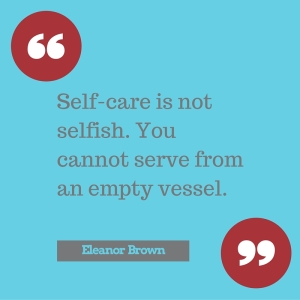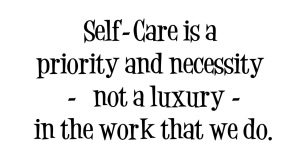Yesterday in the UK (2nd February) was Time To Talk Day, which encourages people to break the silence and talk about mental health problems. I’ve already come across a couple of helpful ELT related posts – Phil Longwell’s brave and honest interview on the Teachers as Workers blog and Sandy Millin’s list of useful links on mental health in ELT, but couldn’t help but feel that this should give me the impetus to write a post I’ve been meaning to write for ages.
One in four people are estimated to suffer from mental health problems every year, which means that it’s far more common than a lot of people think. I’ve struggled with depression and anxiety on and off since my early teens, and although my mental health has thankfully never prevented me from teaching (if anything it’s been helped by it) it has certainly negatively affected my life outside of work.
That brings me to this post.
What is self care? Well, it’s about taking proper care of yourself, identifying your own needs and taking steps to make sure that they are met.
Why is self-care important? English language teaching is far from the easiest of professions – low wages, variable (and often not great) work conditions, added to the stress and uncertainty for many people of moving to a new country. Adapting to a new culture can be really challenging, especially if you don’t necessarily speak the language. It’s also a job which means you’re constantly dealing with people, yet the need to maintain professionalism means that you can end up feeling quite isolated if you’ve got any personal problems going on.
I love teaching, but let’s face it, it can be difficult, stressful, and downright disheartening at times. Whether you suffer from mental health problems or not, there’s no harm to be done by taking a little more care of yourself.
So, here’s my A-Z of Self Care for Teachers. These are all things I’ve tried, or that I routinely use personally, which have helped me feel a little more sane when the anxiety gremlin is knocking at my door. I hope they help you – and if you have any other resources or suggestions I’d love to hear them.

Awareness – Teaching is not an easy job, and EFL teaching, whilst in a different context and with different challenges to teaching in a mainstream school classroom, is still teaching. It’s important to be aware of some of the stresses and strains of working in this profession, as well as where you can get help and support if need be. Organisations like TEA and Teachers as Workers are there to support and offer advice, and don’t overlook your own colleagues, friends and management team. Be aware of the difficulties and challenges that come with teaching (and moving and living abroad if you aren’t working in your home country), and remember that if you’re feeling stressed, anxious, lonely or down, you aren’t alone and it isn’t your fault.
Breathe – If, like me, you’re prone to anxiety, your breathing is one of the first things to go out of the window if you’re stressed or worried. It’s worth taking a few minutes to slow down and breathe, whether it’s first thing in the morning, in the evening after you’ve got home, or even in the middle of a class that’s going wrong. This PDF offers some good tips on how to calm and slow down your breathing, or you can find a similar audio version here. Another helpful technique can be using a simple mindfulness technique to help you focus on your breathing. I often use this before I go to sleep, particularly if I’ve had a difficult day, and find it really helps.
Compassion – I’ve written about self-criticism before, but I really do think it’s important to be kind to yourself. Even if you’ve had a terrible day at work, you’re really struggling with your classes and you’re starting to wonder if you even made the right decision to be a teacher (trust me, we’ve all been there!)… if your best friend came to you with similar problems, would you listen to them and be understanding, or would you spend the whole conversation judging them and being critical? Why not afford the same compassion to yourself? Think I’m just being a hippie? Well, research has shown that people who practise self-compassion are happier, have better relationships with others, bounce back more easily from set-backs, are more resilient, and are less likely to be stressed, anxious or depressed. 
Daydream – I think, as teachers, we often have rather a negative view of daydreaming – we often associate it with that student who never pays attention in class, preferring instead to gaze out of the window! It’s been proven, however, that daydreaming can make you happier, more creative, boost your memory, and even consolidate learning. Next time you’re feeling stressed out or low, why not allow yourself a little daydream break??
Exercise – We all know we need to exercise… and it’s true, if you’re working with young learners teaching alone tends to keep you active. Outside of work, though, it’s quite easy to get into couch potato habits: talking to friends and family on Skype, watching things on Netflix, using social media and so on. Getting regular exercise doesn’t just have physical benefits, it also relieves stress, improves memory, helps you sleep better, and boosts overall mood. So whether it’s taking the stairs instead of the lift, getting off the bus/metro a stop early, joining a local sports club or simply taking the time to go for a walk before or after work, find a way to work some exercise into your weekly (if not daily) routine.
Food – Let’s face it, after a long day in the classroom, the last thing you probably want to do is cook a meal. It’s far easier to grab a ready meal or stop at McDonalds on your way home from work. The same can go for lunch – one of the schools I worked at often used to order a takeaway around lunchtime and it’s pretty hard to resist temptation and go for the healthy option! I’ve always found that the key to eating more healthily is preparation – taking snacks or a packed meal with me makes it far easier to eat a balanced diet rather than immediately going for junk food. If you’re short of ideas (or if packed lunches just remind you of what you used to take to school) this website has lots of great ideas. If you’ve got a microwave available to you why not cook extra at dinner and then take in leftovers the following day? My current personal favourite is homemade miso soup – pack veggies, rice noodles and seasoning in a jam jar, then simply add boiling water when you want to eat.
When it comes to dinner, the problem most EFL teachers face is that many of us don’t finish work until 9 or 10pm. By the time we get home, cooking is the last thing we want to do! As someone who spent four years working on this schedule, it seems to me that there are 3 main options (that aren’t simply getting a takeaway every night!).
- Change your schedule so that you’re eating a larger, main meal at lunchtime, then have something smaller, lighter, and quicker to prepare as your evening meal – either at work, pre-evening class, or after you get home.
- Prepare your meals in advance as much as possible – I can see ‘meal prep’ (where you prepare and store all your meals for the coming week on the weekend, leaving only minimal cooking time on the day) working really well for some teachers. (See here or here for some ideas, if you’re curious).
- Find a selection of quick recipes you really like: for example, these under 20 minute recipes.
I tended to do a combination of all three, depending on my mood, the time of year, and my timetable. It’s also worth bearing in mind that it’s not just what you eat, but how often (which can be tricky to fit around a busy teaching timetable). Low blood sugar can make you ‘hangry’ (hungry+angry), so if you find yourself lacking energy and snapping at your students mid afternoon, this could be why. Another reason to take snacks with you to work!
 Gratitude – The more we dwell on negative thoughts and the bad things that have happened to us, the worse we are likely to perceive things are. Don’t believe me? See here. One way to conquer this is gratitude. Try to take a few minutes out every day just to think about the things you’re grateful for – write them down if that helps. Personally, my best friend and I have an arrangement where we email each other a short list of positive things (or things we’re grateful for) every morning. I find the accountability helps! Keeping a list of things you’re grateful for can feel silly at first, but I promise that once you’ve started, you’ll find there’s more to be grateful for than you first think. Want to find more about the benefits of keeping a gratitude journal? You can find reasons why you should, as well as helpful tips for getting into the habit, here.
Gratitude – The more we dwell on negative thoughts and the bad things that have happened to us, the worse we are likely to perceive things are. Don’t believe me? See here. One way to conquer this is gratitude. Try to take a few minutes out every day just to think about the things you’re grateful for – write them down if that helps. Personally, my best friend and I have an arrangement where we email each other a short list of positive things (or things we’re grateful for) every morning. I find the accountability helps! Keeping a list of things you’re grateful for can feel silly at first, but I promise that once you’ve started, you’ll find there’s more to be grateful for than you first think. Want to find more about the benefits of keeping a gratitude journal? You can find reasons why you should, as well as helpful tips for getting into the habit, here.
Hobbies – It can seem like teaching takes up all your time, especially if you’re new to the job and find you’re spending much of your weekends and evenings planning. Remember that it’s important to have a life too! Either look into continuing (or restarting) an old hobby, or see if you can take up something new.
Imagine – When you’re faced with a problem (even one that seems insurmountable), rather than focusing on all the ways things could go wrong, why not try imagining what could go right? I find that often a simple change of perspective can help me to find solutions or even simply steps forwards that I hadn’t previously considered.
Judgement – In a previous blog post I discussed ways of dealing with the ‘inner critic’ – that nasty little voice in your head that tells you you’re a failure and everything’s headed for disaster. I think it’s worth reiterating here: one of the most important things you can do to look after yourself is not to judge yourself. Everyone has difficult classes, everyone teaches less than perfect lessons, and everyone feels low or isolated or homesick occasionally. Don’t beat yourself up for how you feel!
Kindness – Doing something to help others has a positive effect on our own happiness too. If it’s not possible for you to volunteer with or donate to a charity (volunteering can be harder to organise when you’re not in your own country, especially if you’re in a bit of a TEFL teacher bubble, and different people have different financial situations), why not look a bit closer to home? Write a note to a colleague telling them you appreciate them, buy a friend a bar of chocolate, offer to do your flatmate’s chores or call or email someone you haven’t spoken to in a while.
Laugh – Laughter therapy is a thing. When we laugh, our body relaxes and endorphins (natural painkillers) are released into the blood stream. This is a great natural stress-buster! If everything’s getting on top of you, watch a couple of episodes of your favourite sitcom, see a film, or even just look up jokes online. I also like to keep a little record of funny things my students have said in class – never fails to make me smile!
Mindfulness – Paying more attention to the present moment – to your own thoughts and feelings, and to the world around you – can improve your mental wellbeing. Personally I’ve found this to be one of the most helpful things in dealing with my own depression and anxiety. You can find some tips on exploring mindfulness here, if it’s something you’d like to try.
Negative thoughts (learning to deal with them) – It’s completely normal to have negative thoughts, everyone does! Stopping having negative thoughts should never be a goal; it’s far more important to learn to deal with them when they do appear. As with dealing with the inner critic, the first step to overcoming negative thoughts is to recognise them. Once you’ve identified a negative thought, you can then look for evidence to support it (often there won’t be any!), evidence against it, and potentially reframe it (think ‘how can I look at this in a different way?’).

Organise – This might be more of a personal one, but I often find that when things are starting to get too much, organisation and tidiness go out of the window…and the ensuing mess only makes me feel worse. Put on some of your favourite music, open some windows, and have a proper clean and tidy. If everything’s too overwhelming, tackle it bit by bit – say only your desk, or your wardrobe. You don’t have to do everything today.
Play – All work and no play makes Jack a dull boy… and the same goes for teachers too! No matter how many other things you have going on, try to take the time to do something for you, every day. If you’re stuck for ideas, try some of these 50 ways to take a break! Sandy Millin also has a selection of bookmarks on how to maintain work/life balance.

Quiet – With social media, smart phones and easily available wifi it can seem like we’re almost constantly surrounded by noise, information, and people wanting our attention. Choose a short period every so often to disconnect and be in the silence.
Read – I’ve put this one in as I always find reading helps me to relax, but it’s often something I don’t consider to be a priority and so struggle to find the time to do. If you think you don’t have time to read, how about reading on public transport on your way to and/or from school? If that still doesn’t sound like something that would work for you, I love audio books as you can then listen while walking, running, cooking or doing the ironing.
Socialise – Spending time with friends can make you feel much better about things! If you’ve just moved to a new country to start your TEFL adventure it can be tricky to meet new people, especially if you want to build a network of friends outside of English language teaching. Meetup.com can be a great place to start if you want to meet new people – it’s free to join and there are thousands of different groups based around different hobbies and activities. From what I can tell it’s pretty much international – I first joined while living in Prague, and made some great friends.
Talk – It’s important to talk to someone if you are finding things difficult, be that a friend, a colleague, your DOS or a family member. The Time to Talk website shares some conversation starters if you simply don’t know where to start. If you want to talk to someone from a detached perspective, I’m always happy to respond to emails or facebook messages (you can find my email address on the ‘about’ tab at the top of the page).
Understand (you’re not alone) – I’m grateful that more and more people are now talking about mental health – because it is important. If you’re struggling with depression, stress or anxiety (or indeed other mental health issues) please remember that you are not the only one in this situation. Phil Longwell talks openly about mental health and the effects anxiety has had on his life and teaching career in this interview, and Rebecca Cope writes about her experiences here. If you’re looking for more personal stories (not specific to ELT), Time to Talk has quite a collection!
Visit – Whenever I’m completely caught up in whatever’s going on in my head, I find getting a change of scenery really helps. Whether it’s visiting a tourist attraction, taking a mini break and seeing a new town or city, going to a cafe or restaurant or even simply stepping outside your apartment and getting some fresh air, going somewhere different can be a good idea. Why not go with a friend?
Water – We’ve talked already about food, but equally important is water. Dependent on the climate you’re in, aim to drink 6-8 glasses of water a day (around 1.2 litres, more if you’re in a hot climate). If you’re in a country where it isn’t safe to drink the tap water, consider investing in a water filter – it’ll save you loads on bottled water in the long-run.
eXhale – The way we breathe affects our nervous system. If we’re under pressure or stressed, we tend to emphasise the ‘inhale’ section of our breathing, our heart rate rises  and our ‘fight or flight’ mechanism is stimulated. By consciously paying attention to our breathing, and exhaling for longer than we inhale, we can calm our body and our nervous system.
and our ‘fight or flight’ mechanism is stimulated. By consciously paying attention to our breathing, and exhaling for longer than we inhale, we can calm our body and our nervous system.
Yield – Be it anger, resentment, or past memories, there’s something in our minds that likes to cling on to the bad things that have happened to us – and in the long-term that doesn’t do us any good. If you’ve had a bad class, a disagreement with a friend or colleague, or a bad observation, now is always the time to let go. Talk to someone, write a letter, punch your pillow, exercise, or do what ever you need to let your emotions out. Then, make a conscious decision to let it go, and move on.
Zzzz – I struggled with low mood quite a bit in my first year of living and teaching abroad, and this was largely due to sleep – or lack thereof. I finished teaching at 9-9:30pm, came home, ate dinner, and then stayed up until 2 or 3am talking to friends back at home on Skype – not helped by the 4 hour time difference. The amount of sleep we need varies from person to person (I’ve always needed more than the average to feel well-rested), but it’s generally advised that we need between 7 and 9 hours’ sleep a night. Many of us don’t get anywhere near that, and sleep deprivation can lead to moodiness, irritability, depression and a weakened immune system, as well as more serious health issues. Getting enough sleep (and aiming to make it good quality sleep too!) is an easy way to look after yourself just a little bit more.







 Gratitude – The more we dwell on negative thoughts and the bad things that have happened to us, the worse we are likely to perceive things are. Don’t believe me? See
Gratitude – The more we dwell on negative thoughts and the bad things that have happened to us, the worse we are likely to perceive things are. Don’t believe me? See 

 and our ‘fight or flight’ mechanism is stimulated. By consciously paying attention to our breathing, and exhaling for longer than we inhale, we can calm our body and our nervous system.
and our ‘fight or flight’ mechanism is stimulated. By consciously paying attention to our breathing, and exhaling for longer than we inhale, we can calm our body and our nervous system. One of the challenges of teaching lower level students is knowing when, and how, to grade your language. Although by the end of my Trinity I’d just about got my head around how to talk to elementary students, I still tended to find that I’d frequently be greeted by blank stares for the first few minutes of the lesson – before I’d graded my language enough to be easily understood. The first time I taught beginner students I had no idea how to speak to them!
One of the challenges of teaching lower level students is knowing when, and how, to grade your language. Although by the end of my Trinity I’d just about got my head around how to talk to elementary students, I still tended to find that I’d frequently be greeted by blank stares for the first few minutes of the lesson – before I’d graded my language enough to be easily understood. The first time I taught beginner students I had no idea how to speak to them!


 nt refuses to participate in an activity, again, that’s fundamentally their problem. I’ll explain to them my rationale for doing it and why participating would be beneficial for them, but at the end of the day I cannot force them to do something they don’t want to do. In this situation I’d simply devote my attention to the other students and ensure they get the most out of the activity as possible.
nt refuses to participate in an activity, again, that’s fundamentally their problem. I’ll explain to them my rationale for doing it and why participating would be beneficial for them, but at the end of the day I cannot force them to do something they don’t want to do. In this situation I’d simply devote my attention to the other students and ensure they get the most out of the activity as possible.